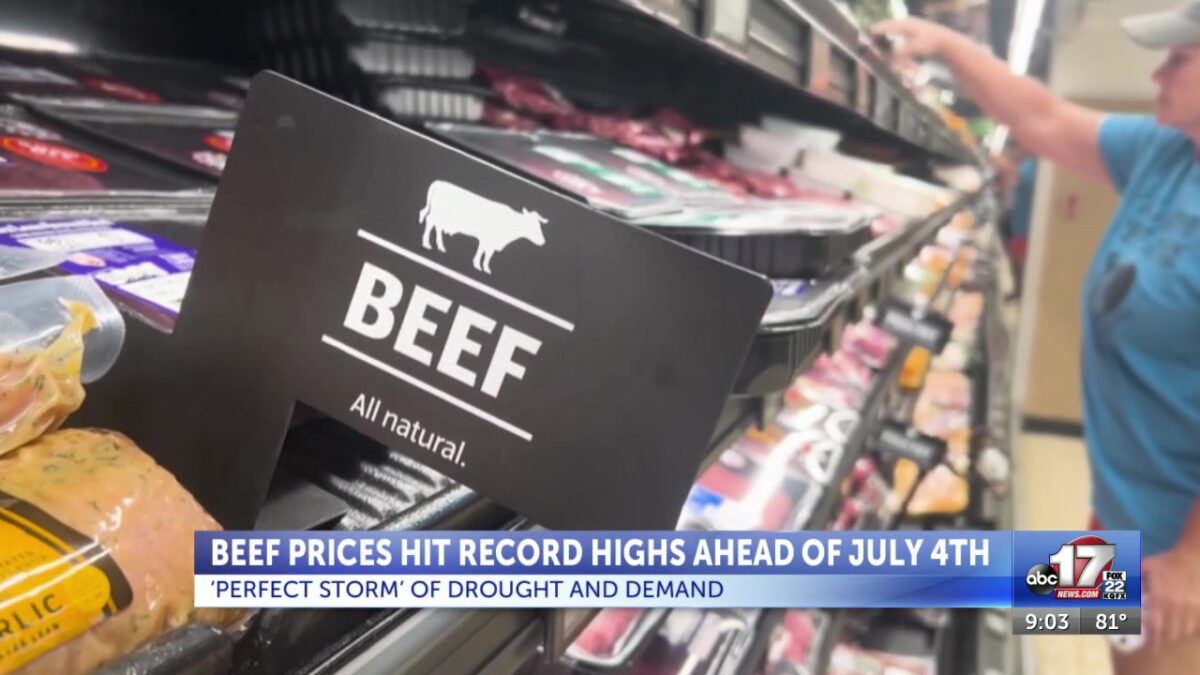‘Perfect storm’ of drought, demand sends beef prices soaring ahead of Independence Day

Mitchell Kaminski
COLUMBIA, Mo. (KMIZ)
As Missouri families fire up their grills for the Fourth of July, many will notice a sting at the checkout counter.
Beef prices have surged to record highs, fueled by a “perfect storm” of drought, inflation and shrinking cattle herds — and Missouri farmers are feeling the squeeze.
Ground beef prices reached an all-time high of $5.98 per pound in May, according to the U.S. Bureau of Labor Statistics. That’s a 49% jump from five years ago, driven by inflation and a historic drop in beef cattle supply.
“Past drought conditions, not just here in Missouri but across the country, have been a major factor,” said Patrick Westhoff, who is the director of the University of Missouri’s Food and Agricultural Policy Research Institute. “We have a lot fewer cows than we’ve had in the past. Fewer cows means fewer calves, fewer calves means less beef being produced.”
Missouri ranks 10th nationally in beef production, producing more than 1.3 billion pounds annually. But many producers have been forced to send cattle to slaughter early or downsize herds due to drought and rising input costs.
“The current situation we’re facing is really kind of a perfect storm of supply and demand factors,” said Wesley Tucker, a livestock economist and field specialist at the University of Missouri. “We’ve experienced several years of back-to-back droughts which forced many producers to send cattle to market and downsize their herds. While the cattle inventory was dropping to 60-plus-year lows, we’ve also seen really strong demand for beef among consumers.”
Tucker said that pressure is peaking at the worst time for consumers.
“We’re seeing low supply and high demand colliding right during the perfect grilling season,” Tucker said. “Markets often peak around July Fourth as people gather and head outside to grill during summer activities. So, we’ve kind of got a perfect storm created.”
Westhoff said demand has remained surprisingly strong, despite soaring prices.
“We’ve had a very strong consumer demand for beef,” he said. “So this year, in spite of very high prices, it looks like we’ll have about the same level of per-capita beef consumption we had a year ago.”
But rebuilding the nation’s beef supply won’t happen overnight. The cattle cycle is notoriously slow to recover, especially after years of drought have depleted breeding stock.
“When a cattleman has to send a cow to slaughter because they have nothing to feed them, it means one less production factory available to produce beef,” Tucker said. “It takes a year before she’s old enough to be bred and then nine months to produce a calf. Then it’s an additional 18 months before her calf is finished and ready to go to the packing house.”
That lag means higher prices could stick around for years.
“We still haven’t hit the bottom on beef cattle numbers,” Westhoff said. “It appears they may still have another year of reduced beef production in front of us, which will tend to support prices almost to maybe 2027 or even 2028 before we finally see the cycle turn to increase in beef production and result in lower prices.”
Tucker said that beyond weather, inflation has hit producers just as hard as consumers.
“Everything a farmer has to buy such as feed, fuel, machinery and interest expense made it tough on farmers,” Tucker said. “Market conditions didn’t encouraged expansion of the herd so it’s going to take time for things to level out. ”
The impact of tariffs has also created uncertainty. Westhoff noted that trade policy and tariffs are contributing to price pressures as well.
“In the case of Australia, for example, their beef export industries have to pay the tariffs. That’s a 10% tariff,” Westhoff said. “So it’s not a huge tariff, but it is large enough… it tends to keep prices higher than those would be here.”
Still, Westhoff warned that tariffs could backfire for U.S. farmers if other countries retaliate.
“At some point in the future, you know, they may do some retaliation against U.S. tariffs that could actually hurt U.S. exports and therefore reduce prices,” he said.
For Missouri ranchers and consumers alike, the reality is clear: Beef is more expensive, and it could stay that way for some time.
“When multiple years of drought occur and cattlemen are forced to sell off their livelihood because they simply don’t have anything to feed them,” Tucker said. “It’s really hard on them both physically and mentally.”